#public domain publications
Explore tagged Tumblr posts
Text
It looks like Mickey has something to say
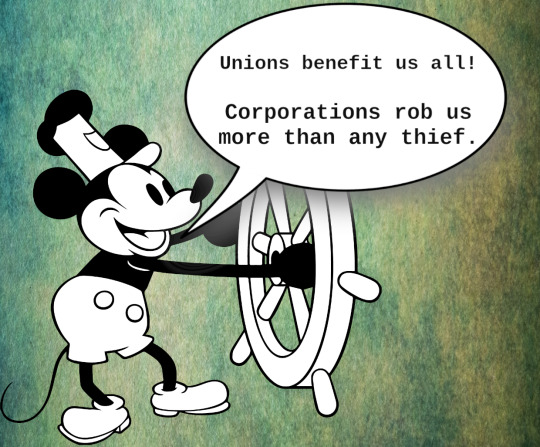
60K notes
·
View notes
Text
Every year The Internet Archive hosts a competion to make art using newly public domain materials, and I've been losing my mind at this submission:
https://archive.org/details/555-milf-tar/
8K notes
·
View notes
Text
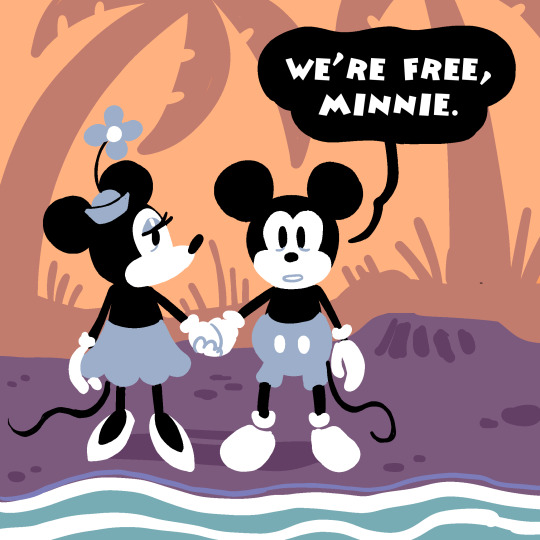

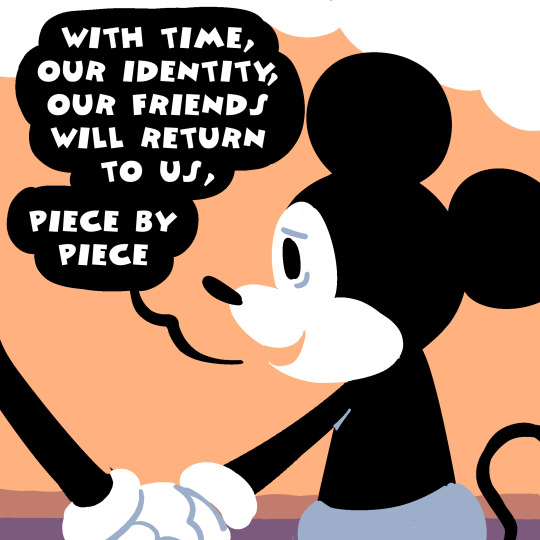

the undying love of mickey mouse
#mickey mouse#minnie mouse#steamboat willie#michael is finally public domain#art#comics#tanookitalez
40K notes
·
View notes
Text
I was meeting a client at a famous museum’s lounge for lunch (fancy, I know) and had an hour to kill afterwards so I joined the first random docent tour I could find. The woman who took us around was a great-grandmother from the Bronx “back when that was nothing to brag about” and she was doing a talk on alternative mediums within art.
What I thought that meant: telling us about unique sculpture materials and paint mixtures.
What that actually meant: an 84yo woman gingerly holding a beautifully beaded and embroidered dress (apparently from Ukraine and at least 200 years old) and, with tears in her eyes, showing how each individual thread was spun by hand and weaved into place on a cottage floor loom, with bright blue silk embroidery thread and hand-blown beads intricately piercing the work of other labor for days upon days, as the labor of a dozen talented people came together to make something so beautiful for a village girl’s wedding day.
What it also meant: in 1948, a young girl lived in a cramped tenement-like third floor apartment in Manhattan, with a father who had just joined them after not having been allowed to escape through Poland with his pregnant wife nine years earlier. She sits in her father’s lap and watches with wide, quiet eyes as her mother’s deft hands fly across fabric with bright blue silk thread (echoing hands from over a century years earlier). Thread that her mother had salvaged from white embroidery scraps at the tailor’s shop where she worked and spent the last few days carefully dying in the kitchen sink and drying on the roof.
The dress is in the traditional Hungarian fashion and is folded across her mother’s lap: her mother doesn’t had a pattern, but she doesn’t need one to make her daughter’s dress for the fifth grade dance. The dress would end up differing significantly from the pure white, petticoated first communion dresses worn by her daughter’s majority-Catholic classmates, but the young girl would love it all the more for its uniqueness and bright blue thread.
And now, that same young girl (and maybe also the villager from 19th century Ukraine) stands in front of us, trying not to clutch the old fabric too hard as her voice shakes with the emotion of all the love and humanity that is poured into the labor of art. The village girl and the girl in the Bronx were very different people: different centuries, different religions, different ages, and different continents. But the love in the stitches and beads on their dresses was the same. And she tells us that when we look at the labor of art, we don’t just see the work to create that piece - we see the labor of our own creations and the creations of others for us, and the value in something so seemingly frivolous.
But, maybe more importantly, she says that we only admire this piece in a museum because it happened to survive the love of the wearer and those who owned it afterwards, but there have been quite literally billions of small, quiet works of art in billions of small, quiet homes all over the world, for millennia. That your grandmother’s quilt is used as a picnic blanket just as Van Gogh’s works hung in his poor friends’ hallways. That your father’s hand-painted model plane sets are displayed in your parents’ livingroom as Grecian vases are displayed in museums. That your older sister’s engineering drawings in a steady, fine-lined hand are akin to Da Vinci’s scribbles of flying machines.
I don’t think there’s any dramatic conclusions to be drawn from these thoughts - they’ve been echoed by thousands of other people across the centuries. However, if you ever feel bad for spending all of your time sewing, knitting, drawing, building lego sets, or whatever else - especially if you feel like you have to somehow monetize or show off your work online to justify your labor - please know that there’s an 84yo museum docent in the Bronx who would cry simply at the thought of you spending so much effort to quietly create something that’s beautiful to you.
#shut up e#long post#Saturday thoughts#this has been in my drafts for a week haha#also this is the heart of why AI art feels so wrong#forget the discussion of copyright and theft etc - even if models were only trained on public domain they would still feel very wrong#because they’re not art. art is the labor of creation#even commercial art and art commissioned by the popes and kings of history: there is humanity in the labor of it#unrelated: I did not know living in the Bronx was now something to brag about. How the fuck do y’all New Yorkers afford this city???
28K notes
·
View notes
Text
I can't believe more people don't know about the antique pattern library! All those public domain, vintage handiwork books and magazines are scanned in pdf format, and FREE TO DOWNLOAD! Languages include French, Italian, German, and English. It just does need to be mentioned that most of the earlier English publications are British, so American users need to make sure to convert the instructions as necessary. Especially crochet instructions, where a British double crochet is an American single. No, I don't know why 🤣

Publications include (for those who can't see the picture) :
Battenberg Lace, Beading, BerlinWork, Bobbin lace, Bookbinding (yes, bookbinding!!!)
Calligraphy, Carpentry, Crochet, Cross Stitch, Cutwork
Drawing, Dressmaking
Embroidered Net, Embroidery
Filet, Filet Crochet, Flower Arranging
Glass
Hardanger
Irish Crochet
Knitting, Knotting
Lace (soooo many forms of lace making)
Macrame
Paper, Point Lace
Quilting
Ribbonwork
Sewing
Tatting, Tulle Embroidery
Various
Waxwork, Woodworking
Workbasket Magazine -- a publication that usually posted multiple different crafts in each issue.
It's a wonderful site, and I've loved it for nearly 20 years!
Antiquepatternlibrary.org
K so not to be dramatic or anything, but there's a free vintage French pattern book available on antiquepatternlibrary so if you like to crochet/weave/make pixel art/tie epic friendship bracelets don't walk- RUN.
It has scenes from aesop's fables! Cherubs doing things! Beheadings! Greek muses! Little farm people! Intricate floral pattern! Goth stained-glass window like patterns! Fun little corner pieces! Eeeeeeeeeeeeee
https://www.antiquepatternlibrary.org/html/warm/C-TT008-180.htm

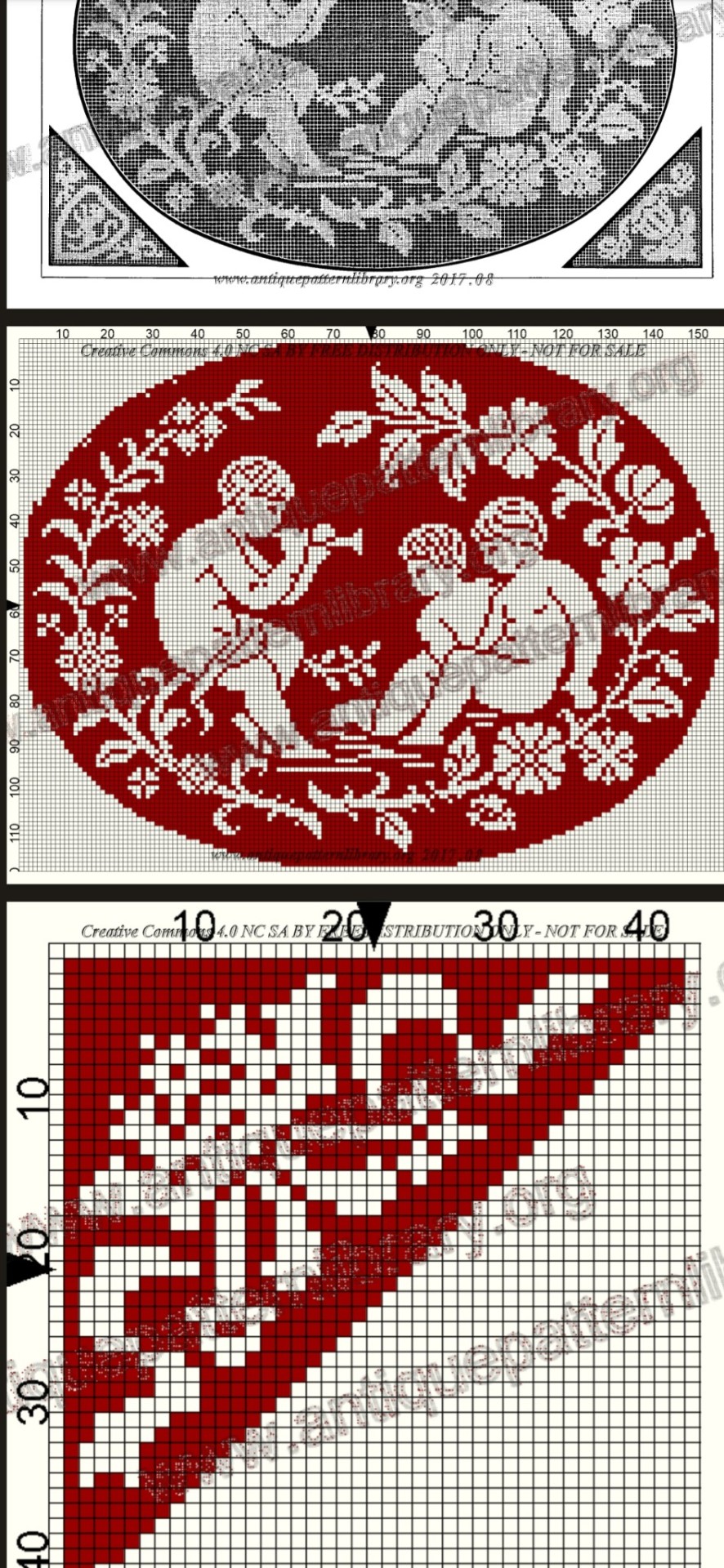
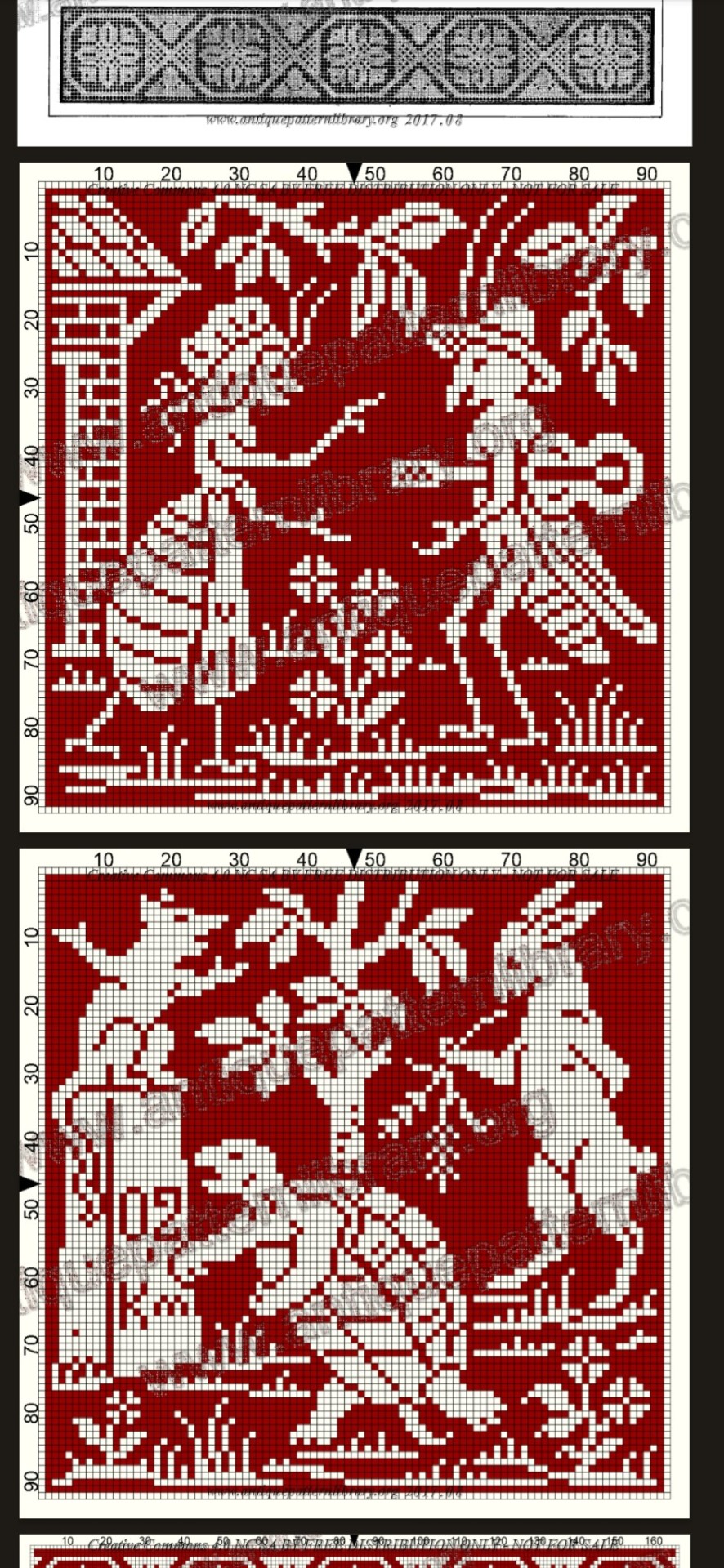
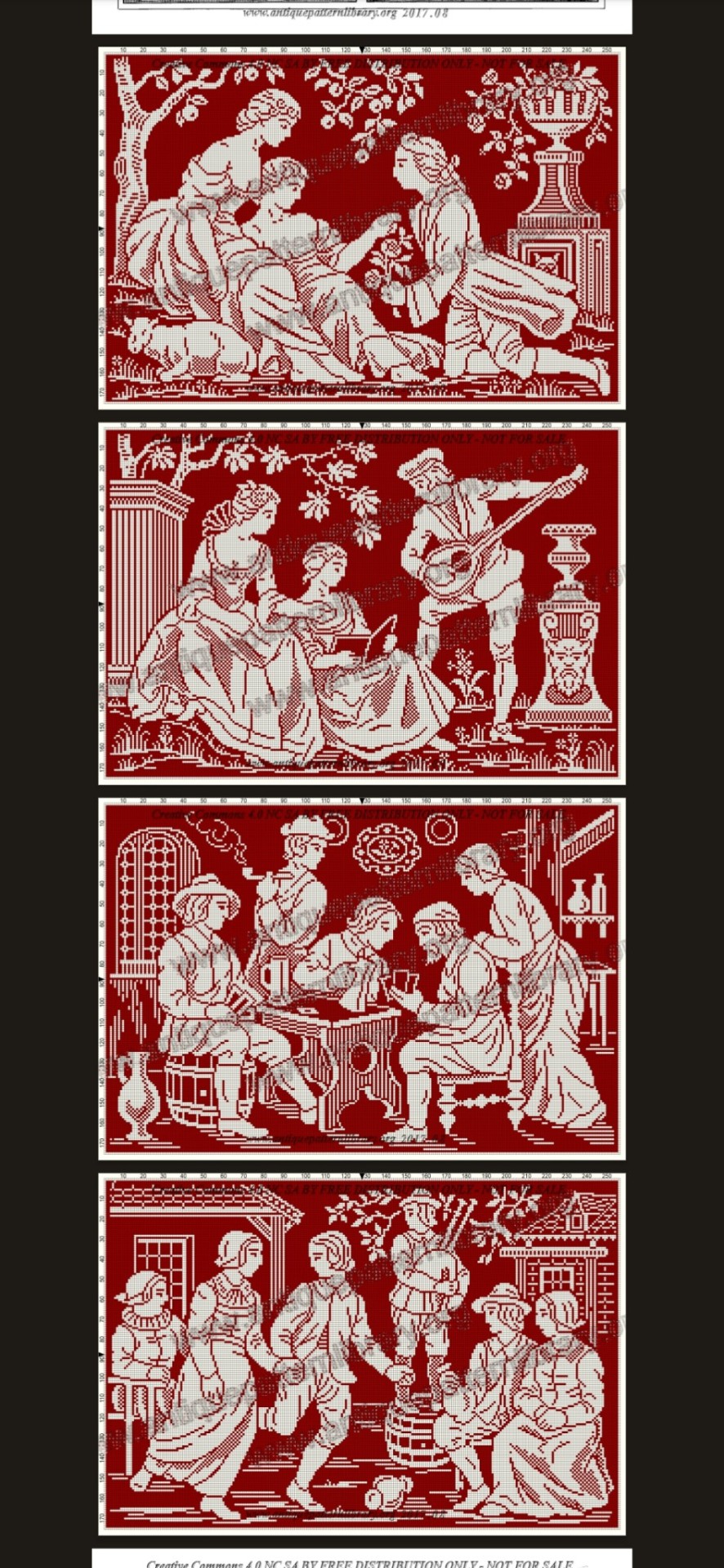


#antique pattern library#vintage patterns#public domain publications#knitting patterns#crochet patterns#Embroidery#handiwork#vintage handiwork#irish crochet#cutwork#lacemaking#AAAAAALLLLthelacemaking#not even kidding about the lacemaking
32K notes
·
View notes
Text

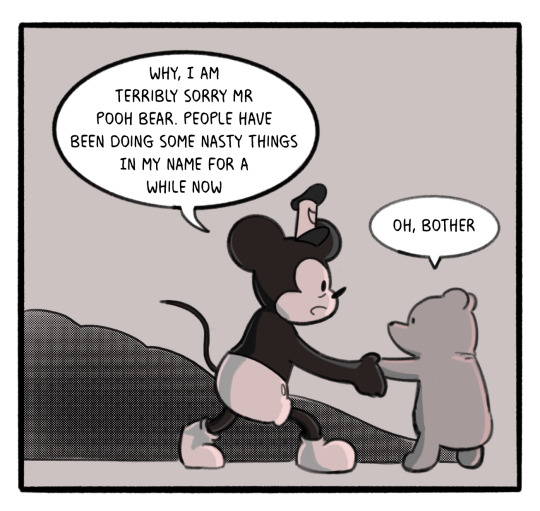
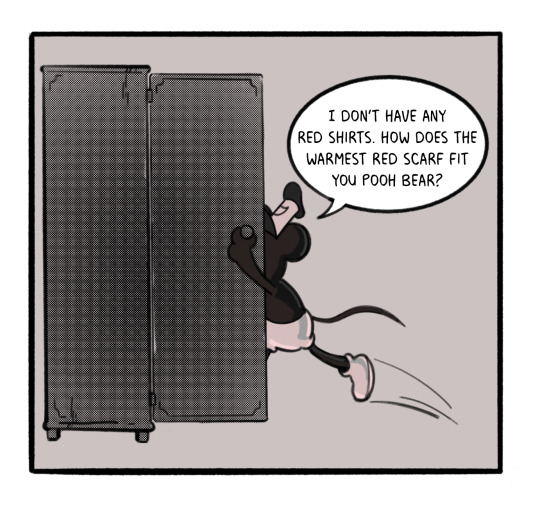
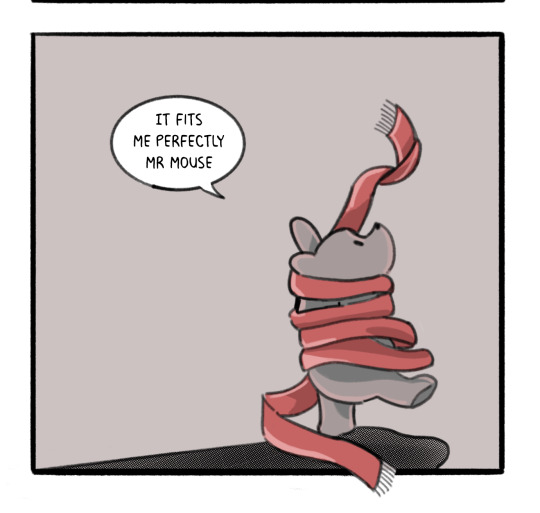
Happy Mickey Mouse is mine day
#mickey mouse#winnie the pooh#pjdraws#comics#art#web comics#public domain#steamboat willie#pooh bear#alt text#alt text comics#Winnie & Willie#Willie & Winnie#my comics
33K notes
·
View notes
Text
people are drawing Steamboat Willie Mickey doing all this crazy shit and whatnot, but you could always do that. you can do that now, with current Mickey, just fine. it's fanart and it's legally protected. hell you could take Disney-drawn Mickey and put a caption about unions or whatever on it and it would still be protected under free speech and sometimes even parody law.
what is special about public domain is that you can SELL him. you could take a screenshot and sell it on a tshirt. you can use him to advertise your plumbing business. people have already uploaded and monetized the original film.
you could always have Mickey say what you want, but now you can profit off it.
#steamboat willie#Mickey mouse#Disney#public domain#you can't trademark him as like a logo or mascot of your plumbing business i just mean like#you can slap him in your commercial or side of the van#i just have seen soooo many people make ORIGINAL art of him and I'm like#no that's not the point!! you can already do that!!!#(obvs if it's a comic or something talking about him being free or whatever then yeah like i get it)#(but those people who put him as a fighter in their game?? Quinton reviews uploading the original video?? boss shit)#(THAT'S what it's about)
30K notes
·
View notes
Text
Fyi
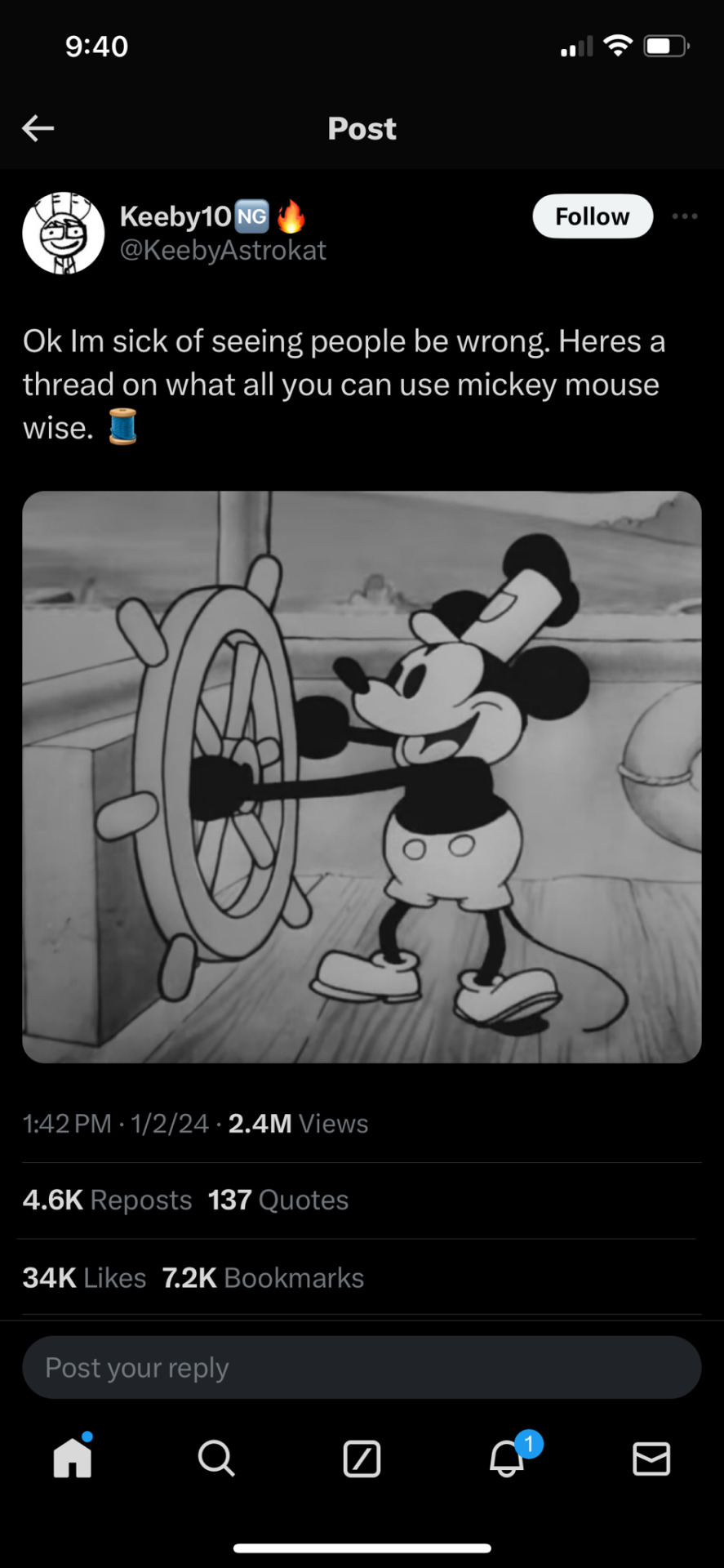
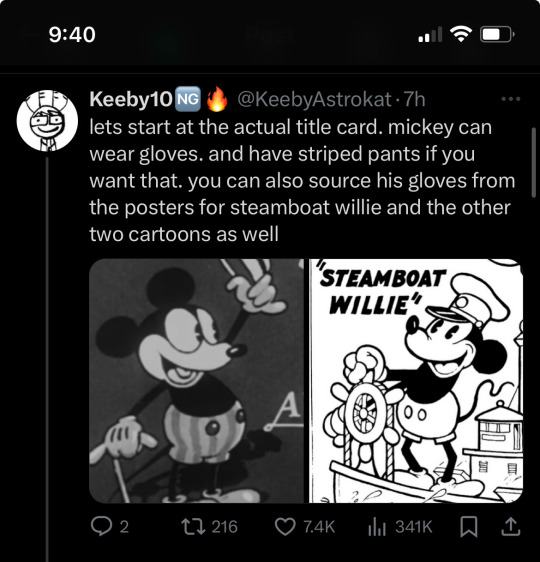


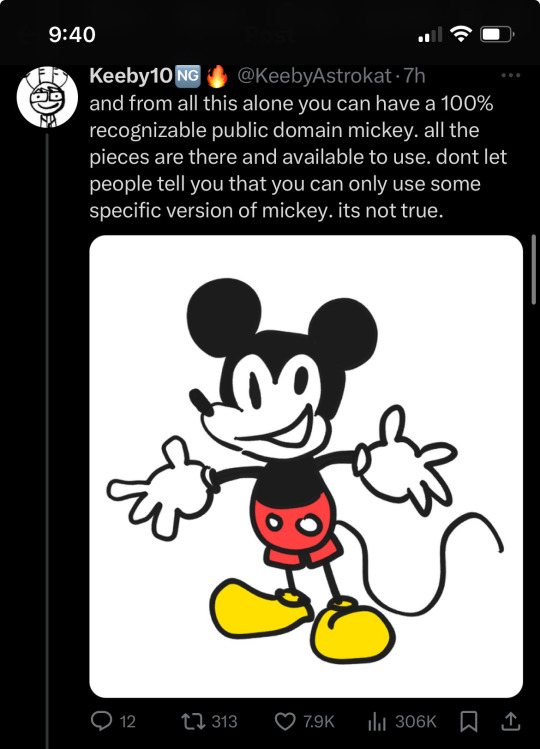

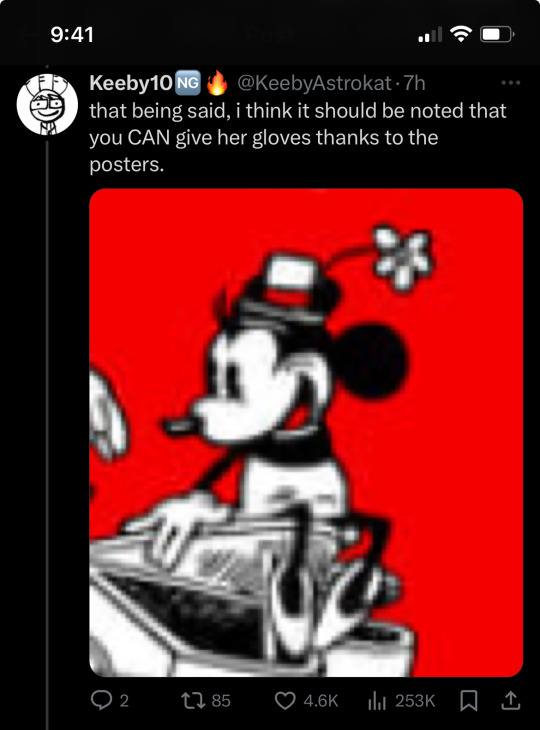
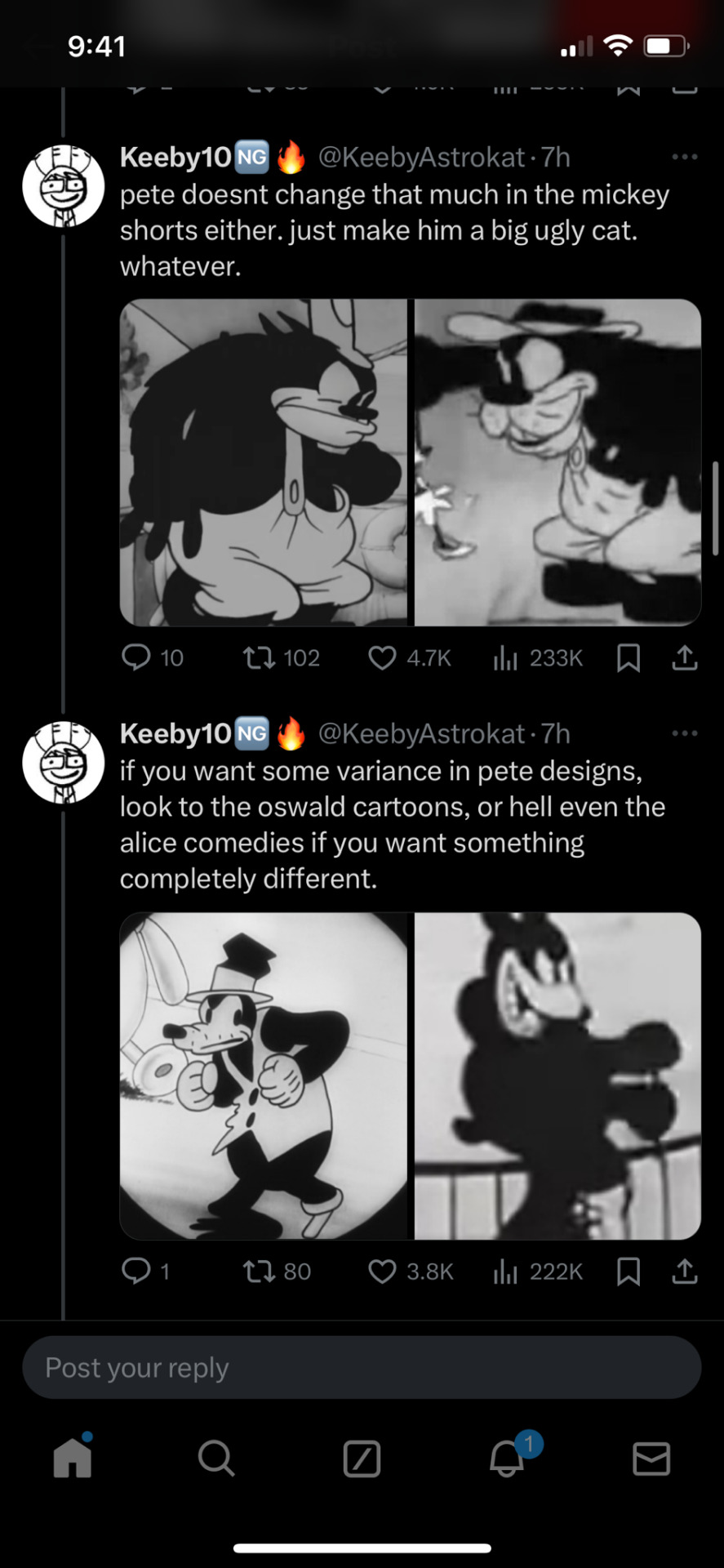
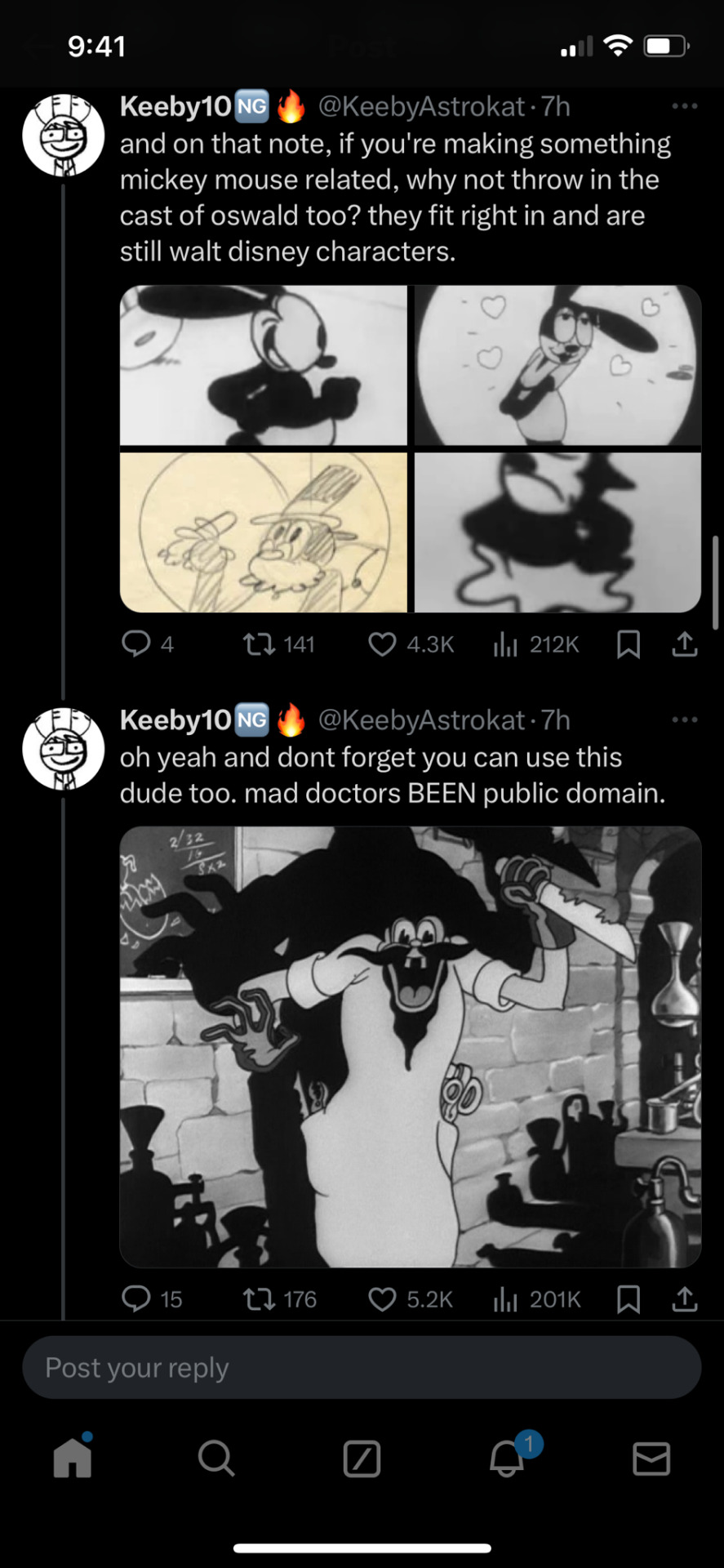

( x )
Happy creating folks
24K notes
·
View notes
Text
Happy Public Domain Day 2025!
It is the first of January, so works from 1929 are now public domain in the United States. Here are some of them.
youtube
The Skeleton Dance, drawn by Ub Iwerks, music by Carl Stalling.
youtube
The Cocoanuts, the first Marx Brothers film (not counting an earlier unreleased silent film).
youtube
"Ain't Misbehavin'," by Andy Razaf, Fats Waller, Harry Brooks. (Only the composition is public domain, not this particular recording, which is from 1943. But hey, any chance to play a clip from Stormy Weather is a good one.)
youtube
“Rhapsody in Blue,” performed by Paul Whiteman and His Orchestra. (As a sound recording -- the composition, by George Gershwin, was already public domain.)

The Treachery of Images, by René Magritte.

The earliest "Thimble Theaters" comics featuring Popeye the Sailor.

A Farewell to Arms, by Ernest Hemingway
And many, many other works, which you can read about here. Happy Public Domain Day!
4K notes
·
View notes
Text
Happy Public Domain Day 2025 to all who celebrate
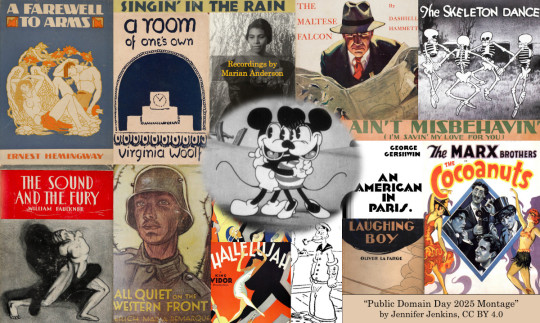
If you'd like an essay-formatted version of this post to read or share, here's a link to it on pluralistic.net, my surveillance-free, ad-free, tracker-free blog:
https://pluralistic.net/2024/12/17/dastar-dly-deeds/#roast-in-piss-sonny-bono

In 1976, Congress set fire to the country's libraries; in 1998, they did it again. Today, in 2024, the flames have died down, and out of the ashes a new public domain is growing. Happy Public Domain Day 2025 to all who celebrate!
For most of US history, copyright was something you had to ask for. To copyright a work, you'd send a copy to the Library of Congress and they'd issue you a copyright. Not only did that let you display a copyright mark on your work – so people would know they weren't allowed to copy it without your permission – but if anyone wanted to figure out who to ask in order to get permission to copy or adapt a work, they could just go look up the paperwork at the LoC.
In 1976, Congress amended the Copyright Act to eliminate the "formality" of copyright registration. Now, all creative works of human authorship were copyrighted "at the moment of fixation" – the instant you drew, typed, wrote, filmed, or recorded them. From a toddler's nursery-school finger-painting to a graffiti mural on a subway car, every creative act suddenly became an article of property.
But whose property? That was on you to figure out, before you could copy, publish, perform, or preserve the work, because without registration, permissions had to start with a scavenger hunt for the person who could grant it. Congress simultaneously enacted a massive expansion of property rights, while abolishing the title registry that spelled out who owned what. As though this wasn't enough, Congress reached back in time and plopped an extra 20 years' onto the copyrights of existing works, even ones whose authors were unknown and unlocatable.
For the next 20 years, creative workers, archivists, educators and fans struggled in the face of this regime of unknowable property rights. After decades of well-documented problems, Congress acted again: they made it worse.
In 1998, Congress passed the Sonny Bono Copyright Act, AKA the Mickey Mouse Preservation Act, AKA the Copyright Term Extension Act. The 1998 Act tacked another 20 years onto copyright terms, but not just for works that were still in copyright. At the insistence of Disney, Congress actually yanked works out of the public domain – works that had been anthologized, adapted and re-issued – and put them back into copyright for two more decades. Copyright stretched to the century-plus "life plus 70 years" term. Nothing entered the public domain for the next 20 years.
So many of my comrades in the fight for the public domain were certain that this would happen again in 2018. In 2010, e-book inventor and Project Gutenberg founder Michael S Hart and I got into a friendly email argument because he was positive that in 2018, Congress would set fire to the public domain again. When I insisted that there was no way this could happen given the public bitterness over the 1998 Act, he told me I was being naive, but said he hoped that I was right.
Michael didn't live to see it, but in 2019, the public domain opened again. It was an incredible day:
https://archive.org/details/ClosingKeynoteForGrandReopeningOfThePublicDomainCoryDoctorowAtInternetArchive
No one has done a better job of chronicling the fortunes of our fragile, beautiful, bounteous public domain than Jennifer Jenkins and James Boyle of Duke University's Center for the Study of the Public Domain. Every year from 2010-2019, Boyle and Jenkins chronicled the works that weren't entering the public domain because of the 1998 Act, making sure we knew what had been stolen from our cultural commons. In so many cases, these works disappeared before their copyrights expired, for example, the majority of silent films are lost forever.
Then, in 2019, Jenkins and Boyle got to start cataloging the works that were entering the public domain, most of them from 1923 (copyright is complicated, so not everything that entered the public domain in 2019 was from that year):
https://web.law.duke.edu/cspd/publicdomainday/2019/
Every year since, they've celebrated a new bumper crop. Last year, we got Mickey Mouse!
https://pluralistic.net/2023/12/15/mouse-liberation-front/#free-mickey
In addition to numerous other works – by Woolf, Hemingway, Doyle, Christie, Proust, Hesse, Milne, DuBois, Frost, Chaplin, Escher, and more:
https://pluralistic.net/2023/12/20/em-oh-you-ess-ee/#sexytimes
Now, 2024 was a fantastic year for the public domain, but – as you'll see in the 2025 edition of the Public Domain Day post – 2025 is even better:
https://web.law.duke.edu/cspd/publicdomainday/2025/
So what's entering the public domain this year? Well, for one thing, there's more of the stuff from last year, which makes sense: if Hemingway's first books entered the PD last year, then this year, we'll the books he wrote next (and this will continue every year until we catch up with Hemingway's tragic death).
There are some big hits from our returning champions, like Woolf's To the Lighthouse and A Farewell to Arms from Hemingway. Jenkins and Boyle call particular attention to one book: Faulkner's The Sound and the Fury, its title taken from a public domain work by Shakespeare. As they write, Faulkner spoke eloquently about the nature of posterity and culture:
[Humanity] is immortal, not because he alone among creatures has an inexhaustible voice, but because he has a soul, a spirit capable of compassion and sacrifice and endurance…The poet’s voice need not merely be the record of man, it can be one of the props, the pillars to help him endure and prevail.
The main attraction on last year's Public Domain Day was the entry of Steamboat Willie – the first Mickey Mouse cartoon – into the public domain. This year, we're getting a dozen new Mickey cartoons, including the first Mickey talkie:
https://en.wikipedia.org/wiki/Mickey_Mouse_(film_series)#1929
Those 12 shorts represent a kind of creative explosion for the Disney Studios. Those early Mickey cartoons were, each and every one, a hybrid of new copyrighted works and the public domain. The backbone of each Mickey short was a beloved, public domain song, with Mickey's motion synched to the beat (animators came to call this "mickey mousing"). In 1929, there was a huge crop of public domain music that anyone could use this way:
Blue Danube, Pop Goes the Weasel, Yankee Doodle, Here We Go Round the Mulberry Bush, Ach Du Lieber Augustin, Listen to the Mocking Bird, A-Hunting We Will Go, Dixie, The Girl I Left Behind Me, a tune known as the snake charmer song, Coming Thru the Rye, Mary Had a Little Lamb, Auld Lang Syne, Aloha ‘Oe, Turkey in the Straw, My Bonnie Lies Over the Ocean, Habanera and Toreador Song from Carmen, Lizst’s Hungarian Rhapsody No. 2, and Goodnight, Ladies.
These were recent compositions, songs that were written and popularized in the lifetimes of the parents and grandparents who took their kids to the movies to see Mickey shorts like "The Barn Dance," "The Opry House" and "The Jazz Fool." The ability to plunder this music at will was key to the success of Mickey Mouse and Disney. Think of all the Mickeys and Disneys we've lost by locking up the public domain for the past half-century!
This year, we're getting some outstanding new old music for our public domain. The complexities of copyright terms mean that compositions from 1929 are entering the public domain, but we're only getting recordings from 1924. 1924's outstanding recordings include:
George Gershwin performing Rhapsody in Blue, Jelly Roll Morton playing Shreveport Stomp, and an early recording from contralto and civil rights icon Marian Anderson, who is famous for her 1939 performance to an integrated audience of over 75,000 people at the Lincoln Memorial. Anderson’s 1924 recording is of the spiritual Nobody Knows the Trouble I’ve Seen.
While the compositions include Singin' in the Rain, Ain't Misbehavin', An American in Paris, Bolero, (What Did I Do to Be So) Black and Blue, Tiptoe Through the Tulips, Happy Days Are Here Again, What Is This Thing Called, Love?, Am I Blue? and many, many more.
On the art front, we're getting Salvador Dali's earliest surrealist masterpieces, like Illumined Pleasures, The Accommodations of Desire, and The Great Masturbator. Dali's contemporaries are not so lucky: after a century, the early history of the works of Magritte are so muddy that it's impossible to say whether they are in or out of copyright.
But there's plenty of art with clearer provenance that we can welcome into the public domain this year, most notably, Popeye and Tintin. As the first Popeye and Tintin comics go PD, so too do those characters.
The idea that a fictional character can have a copyright separate from the stories they appear in is relatively new, and it's weird and very stupid. Courts have found that the Batmobile is a copyrightable character (Batman won't enter the public domain until 2035).
Copyright for characters is such a muddy, gross, weird idea. The clearest example of how stupid this gets comes from Sherlock Holmes, whose canon spans many years. The Doyle estate – a rent-seeking copyright troll – claimed that Holmes wouldn't enter the public domain until every Holmes story was in the public domain (that's this year, incidentally!).
This didn't fly, so their next gambit was to claim copyright over those aspects of Holmes's character that were developed later in the stories. For example, they claimed that Holmes didn't show compassion until the later stories, and, on that basis, sued the creators of the Enola Holmes TV show for depicting a gender-swapped Sherlock who wasn't a total dick:
https://www.theguardian.com/books/2020/dec/22/lawsuit-copyright-warmer-sherlock-holmes-dismissed-enola-holmes
As the Enola lawyers pointed out in their briefs, this was tantamount to a copyright over emotions: "Copyright law does not allow the ownership of generic concepts like warmth, kindness, empathy, or respect, even as expressed by a public domain character – which, of course, belongs to the public, not plaintiff."
When Mickey entered the public domain last year, Jenkins did an excellent deep dive into which aspects of Mickey's character and design emerged when:
https://web.law.duke.edu/cspd/mickey/
Jenkins uses this year's entry of Tintin and Popeye into the public domain to further explore the subject of proprietary characters.
Even though copyright extends to characters, it only covers the "copyrightable" parts of those characters. As the Enola lawyers wrote, the generic character traits (their age, emotional vibe, etc) are not protected. Neither is anything "trivial" or "minuscule" – for example, if a cartoonist makes a minor alteration to the way a character's pupils or eyes are drawn, that's a minor detail, not a copyrightable element.
The biggest impediment to using public domain characters isn't copyright, it's trademark. Trademark is very different from copyright: foundationally, trademark is the right to protect your customers from being deceived by your competitors. Coke can use trademark to stop Pepsi from selling its sugary drinks in Coke cans – not because it owns the word "Coke" or the Coke logo, but because it has been deputized to protect Coke drinkers from being tricked into buying not-Coke, thinking that they're getting the true Black Waters of American Imperialism.
Companies claim trademarks over cartoon characters all the time, and license those trademarks on food, clothing, toys, and more (remember Popeye candy cigarettes?).
Indeed, Hearst Holdings claims a trademark over Popeye in many traditional categories, like cartoons, amusement parks, ads and clothes. They're also in the midst of applying for a Popeye NFT trademark (lol).
Does that mean you can't use Popeye in any of those ways? Nope! All you need to do is prominently mention that your use of Popeye is unofficial, not associated with Hearst, and dispel any chance of confusion. A unanimous Supreme Court decision (in Dastar) affirm your right to do so. You can also use Popeye in the title of your unauthorized Popeye comic, thanks to a case called Rogers v Grimaldi.
This all applies to Tintin, too – a big deal, given that Tintin is managed by a notorious copyright bully who delights in cruelly terrorizing fan artists. Tintin is joined in the public domain by Buck Rogers, another old-timey character whose owners are scumbag rent-seekers.
Congress buried the public domain alive in 1976, and dumped a load of gravel over its grave in 1998, but miraculously, we've managed to exhume the PD, and it has been revived and is showing signs of rude health.
2024 saw the blockbuster film adaptation of Wicked, based on the public domain Oz books. It also saw the publication of James, a celebrated retelling of Twain's Huck Finn from the perspective of Huck's enslaved sidekick.
This is completely normal. It's how art was made since time immemorial. The 40 year experiment in life without a public domain is at an end, and not a minute too soon.
You can piece together a complete-as-possible list of 2025's public domain (including the Marx Brothers' Cocoanuts, Disney's Skeleton Dance, and Del Ruth's Gold Diggers of Broadway) here:
https://onlinebooks.library.upenn.edu/cce/
#jennifer jenkins#duke center for the public domain#public domain day#trademark#tintin#popeye#copyfight#copyright#roast in piss sonny bono#james boyle#marx brothers#mickey mouse#ravel#bolero#faulkner#hemingway#virginia woolf#steinbeck#skeleton dance#gold diggers of broadway#dali#wicked
4K notes
·
View notes
Text

Steamboat Willie has been in public domain for the last three days, and yet I've seen no one post this Pop Team Epic strip...
16K notes
·
View notes
Text
Mickey Mouse's entry into the public domain comes with significant caveats. While the Mickey Mouse who appears in Steamboat Willie (and other media published in 1928 or earlier) is free to use, there's established precedent that specific elements of a character which appear exclusively in later works which still fall under copyright may be protected, if sufficiently distinctive.
(This is the basis of, e.g., the infamous "Sherlock Holmes can't respect women" lawsuit: the Doyle estate, which at the time owned only a tiny handful of the latest-written stories, the others having already fallen into the public domain, argued that specific personality traits which Holmes exhibits only in those later stories are sufficiently distinctive as to be the valid subject of an infringement claim.)
With respect to various elements of Mickey's visual design, such as his red shorts and signature gloves, the matter is clear: just don't use those for another few years. However, there's another thing Mickey's public domain iterations don't exhibit: speech.
The present consensus among copyright scholars seems to be that "a character speaking" is not sufficiently distinctive as to qualify for protection, but the vocal characterisation with which Mickey Mouse is famously associated may so qualify. So, if you want to be scrupulously safe, you can have him talk, but not in that exact specific voice.
Which raises a fun question: what voice would you give him? Wrong answers only.
17K notes
·
View notes
Text
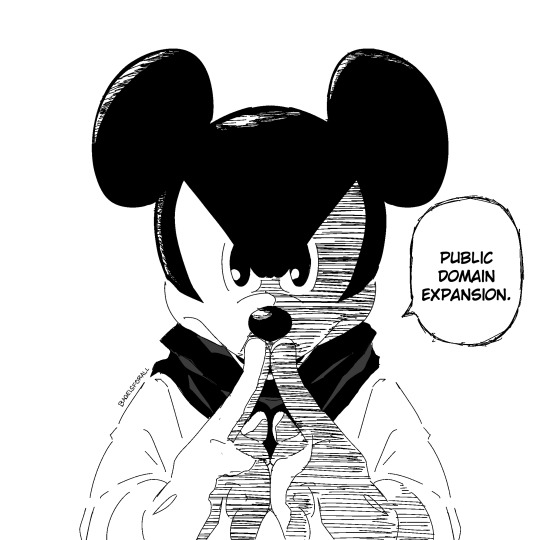

Public Domain Expansion
#mickey mouse#mickey mouse clubhouse#domain expansion#public domain#jjk#jjk memes#jjk fanart#sukuna#ryomen sukuna#jujutsu kaisen#jujutsu sukuna
14K notes
·
View notes
Text

#mickey mouse#steamboat willie#disney#copyright#please holy shit that act was so bad why is no one trying to repeal this#public domain
16K notes
·
View notes
Text
My entire timeline atm:
18K notes
·
View notes
Text
Copy Right and Public Domain in 2025!
It's January 1st 2025 which means it's my favorite unsung holiday! Public Domain Day! This is the day once a year when, in the US, copyrights expire and things enter the public domain, meaning they belong to everyone! even you, Steve!
American copyright for books, movies, art work, and musical compositions (but not recordings, more on that later) runs for 95 years (way too long!) so today works published in 1929 join us in the public domain.
So whats free? so glad you asked.
Popeye the Sailor Man

Many people assume Popeye originated as a cartoon character but thats not true, he comes from a comic strip. The strip was called Thimble Theatre and Popeye was something of a late addition. Thimble Theatre was first published in 1919, so Popeye's girlfriend Olive Oyl has been in the public domain since before the big 20 year copyright freeze of 1998-2019. Popeye first appeared as a minor character 10 years into the strip's run but was so popular he soon took over and the strip would be renamed Popeye less than 5 years later. Now as always whats public is only what appears in 1929, later developments, remain copyrighted. Such as, while Popeye always had super strength its not till 1932 his superpowers were tied to eating spinach, and Olive Oyl originally had a different boyfriend named Ham Gravy, who she dumped for Popeye when he became the main character. It looks like Popeye is following tradition for famous now public domain characters and getting a quicky horror movie this year.
Tintin!

This is personally very exciting as someone who grew up with the Belgian boy detective. Like Popeye I expect a lot of people don't know that Tintin started off as a weekly comic strip. Indeed Tintin appeared as a part of a weekly youth supplement in the Catholic newspaper The Twentieth Century. Any ways, Tintin was first published in there in January 1929, and soon would start what would become the first Tintin story, Tintin in the Land of the Soviets. Now only part of Tintin in the Land of the Soviets was published in 1929, the story line wrapped up in May 1930, so only those 1929 stories and what appears in them is free and clear and Tintin was published in black and white not color. Tintin's author Hergé had no idea what he was doing and was really learning on the job so In The Land of the Soviets is generally seen as his weakest outing and the only one he never opted to redraw in later years. Even so it's nice to see the character free in the world. No word on if Tintin will star in a horror movie.
Buck Rogers (but not really)

The original futuristic space man was published, again a comic strip, in 1929 which means he should enter the public domain today, but he won't. That's because he already is public domain! Before the Copyright Act of 1976 copyright was 28 years with the option to renew for another 28 years. The copyright on the original comic strips was not renewed so ran out at the end of 28 years, 1958. So Buck Rogers has been free and clear for close to 70 years now, whatever you hear about him today.
What else?
Famously last year Mickey Mouse entered the public domain, but all the entered public domain was one (maybe two) animated short, Steamboat Willie. Well this year a dozen Mickey Mouse animated shorts enter the public domain, including the first time Mickey has his iconic white gloves, and the first time Mickey speaks (the first thing Mickey Mouse ever says, voiced by Walt Disney himself, is "Hot dogs! Hot dogs!" in case you were wondering) This will give creators much more to work with if they want to use Mickey in their works which is exciting.
Speaking of Walt Disney, The Skeleton Dance is entering public domain, you likely don't know the title but I suspect you've seen at least part of it at some point

so look for this showing up on TVs in the backgrounds of films and TV shows in the next year or so
Books
The iconic novels of World War I, Ernest Hemingway's A Farewell to Arms and Erich Maria Remarque's All Quiet on the Western Front enter public domain. In fact All Quiet on the Western Front entered public domain last year, but only in the original German, the 1929 translation by Arthur Wesley Wheen is whats entered the public domain now. John Steinbeck's first novel, Cup of Gold, William Faulkner's The Sound and the Fury, Virginia Woolf's A Room of One's Own, and Agatha Christie's Seven Dials Mystery (always get an Agatha Christie novel on this list for the rest of our lives). Dashiell Hammett published both Red Harvest and The Maltese Falcon, later made into one of the greatest films of all time, in 1929. Future children's book author E. B. White (who's go on to write Charlotte's Web and Stuart Little) and future New Yorker cartoonist and humorist James Thurber teamed up to write the delightfully titled Is Sex Necessary? Or, Why You Feel the Way You Do a book of spoof essays making fun of popular books on Freudian sexual theories at the time. The Roman Hat Mystery the first of the long running Ellery Queen mysteries was published, Queen would keep publishing mysteries into the 1970s (and Ellery Queen was a pen name for two people). Richard Hughes' A High Wind in Jamaica and Oliver La Farge's Laughing Boy also came out in 1929 and are in the public domain now. There's much else but those are the highlights sorry if I missed your favorite 1929 novel.
Movies
Alfred Hitchcock and Cecil B. DeMille's first movies with sound, Blackmail and Dynamite respectively, came out in 1929. Marx Brothers' first feature film The Cocoanuts joins the public domain. Other comedy land marks are Harold Lloyd's first sound film, Welcome Danger and Buster Keaton's last silent film, Spite Marriage (which Keaton also directed). John Ford's first sound film, The Black Watch, which also is 21 year old John Wayne's first appearance in a film, as an uncredited extra, he worked in the art department. Hallelujah the first studio film to have an all black cast came out that year. Also worth noting is The Hollywood Revue of 1929 a singing and dancing review, one of the earliest and the movie that popularized the song Singin’ in the Rain, maybe the first time a movie made a song a hit.
Musical compositions
musical compositions, ie the lyrics and musical notations you might see on sheet music are governed by the 1976 Copyright Act, and music written in 1929 is public domain. Music recordings are governed by a whole different law (we'll get there). Songs written in 1929 include Singin’ in the Rain by Arthur Freed & Nacio Herb Brown, Ain’t Misbehavin’ and Black and Blue by the legendary Fats Waller, What Is This Thing Called Love? by Cole Porter, Tiptoe Through the Tulips by Alfred Dubin, You Were Meant for Me by Arthur Freed & Nacio Herb Brown, and also Happy Days Are Here Again by Jack Yellen which would become FDR's campaign theme song in 1932.
Art!
a number of pieces by Salvador Dalí including:
Illumined Pleasures

The Accommodations of Desire

The Great Masturbator
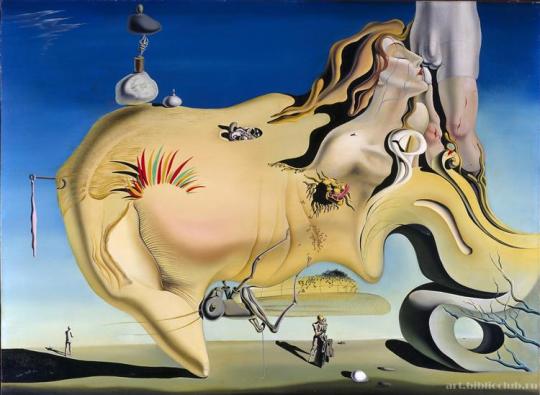
are entering the public domain as is René Magritte’s The Treachery of Images.
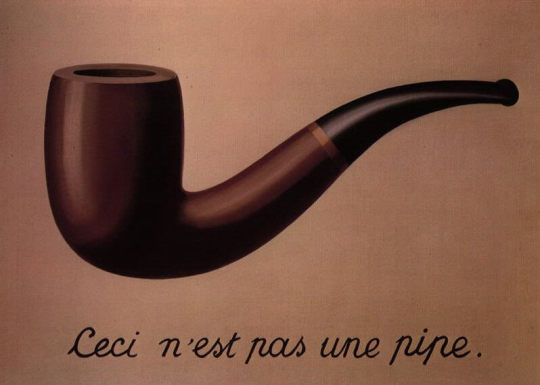
Art is hard because while movies and books are clearly "published" and put on sale, what counts as "published" for a piece of art? the law is not totally sure.
Musical Recordings
as I promised, we got here. Till 2017 there were no federal laws governing the copyright of music recordings before the 1970s, it was governed by a confusing patchwork of state laws and it was not totally clear what was or was not free and clear even from the very earliest recordings ever. Now the term of a music recording's copyright is set at 100 years (way too long) so music recorded in 1924 is now public domain such as. Nobody Knows the Trouble I’ve Seen by Marian Anderson, Everybody Loves My Baby (But My Baby Don’t Love Nobody But Me) by Louis Armstrong, California Here I Come by Al Jolson, Rhapsody in Blue by George Gershwin, Shreveport Stomp by Jelly Roll Morton, Mama’s Gone, Good Bye by Ray Miller, and It Had To Be You by Marion Harris. Now many recordings a lot less famous can finally be preserved and digitized to save them for the next 100 years. Many abandoned works are literally rotting away since without the copyright holder's permission digitizing a work isn't legal.
#Copyright#public domain#public domain day#Popeye#Tintin#the adventures of tintin#Mickey Mouse#Disney#buster keaton#the marx brothers#louis armstrong#cole porter#singin' in the rain#alfred hitchcock#salvador dali#Agatha Christie#Ernest Hemingway#virginia woolf#John Steinbeck#William Faulkner
3K notes
·
View notes